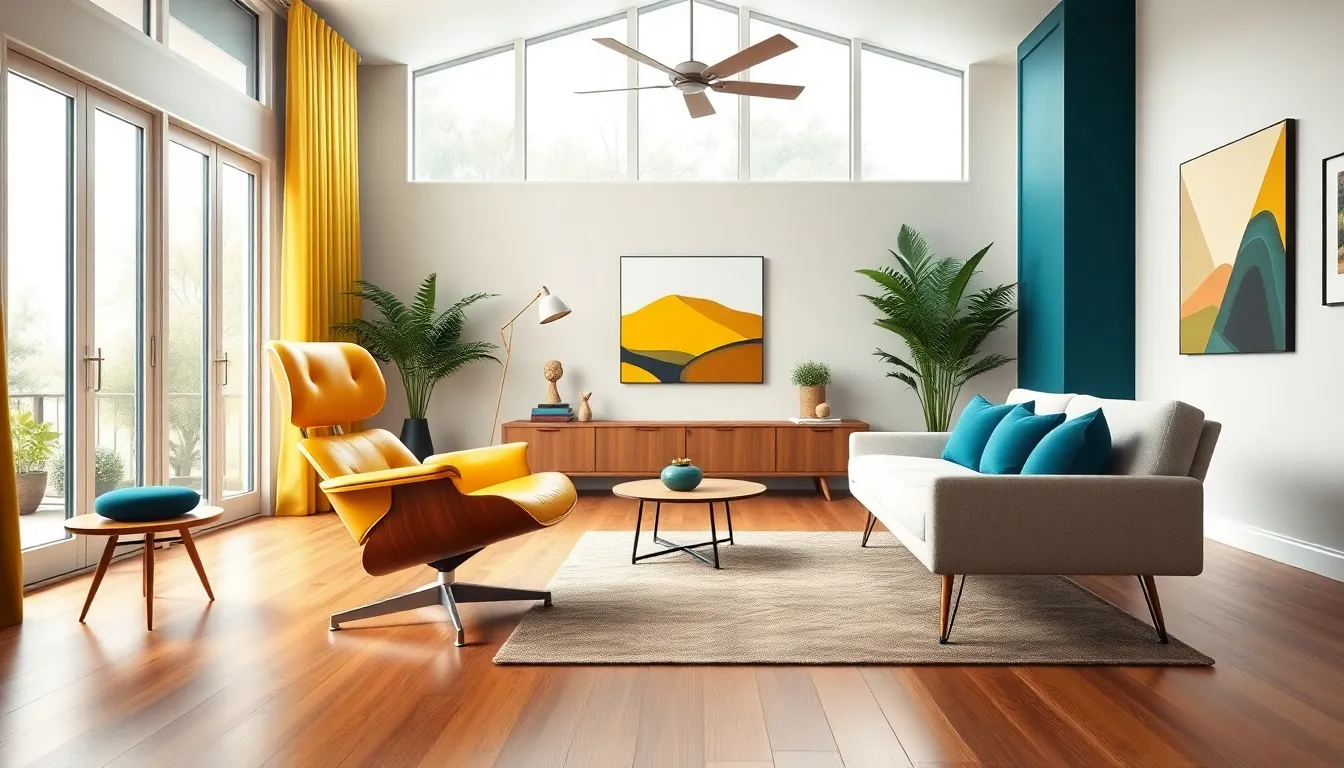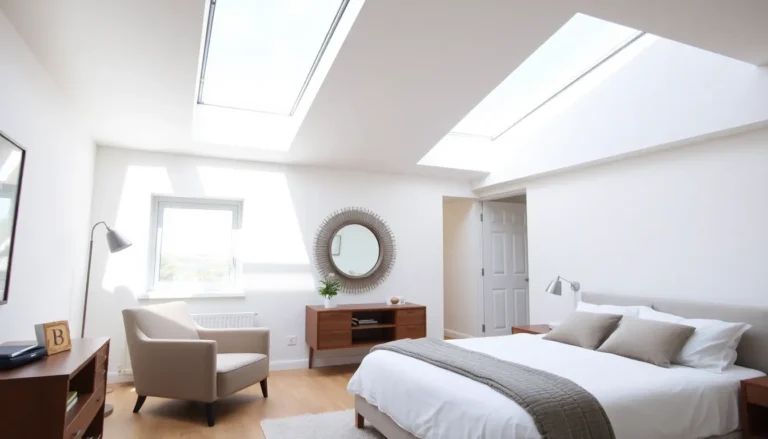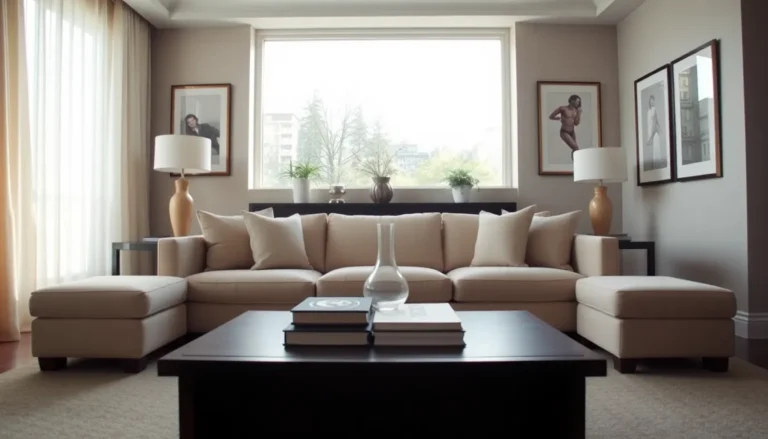Mid-century modern design isn’t just a style; it’s a lifestyle that invites you to kick back and embrace a world of sleek lines and vibrant colors. Imagine a space where form meets function, and every piece of furniture tells a story that screams sophistication. If you’ve ever dreamt of living like Don Draper but without the heavy drinking, this design movement is your ticket to a chic, timeless aesthetic.
Table of Contents
ToggleOverview of Mid Century Modern
Mid-century modern design emerged from the mid-20th century, predominantly between the 1940s and 1960s. This movement reflects a shift towards simplicity, functional aesthetics, and organic forms. Iconic designers like Charles and Ray Eames, George Nelson, and Eero Saarinen created pieces that continue to influence contemporary design.
Shapes and materials play a significant role in mid-century modern furniture. Clean lines and geometric forms often characterize this design. Designers used materials like molded plastic, plywood, and fiberglass, showcasing innovation and accessibility.
Color palettes typically embrace vibrant hues, including mustard yellow, teal, and avocado green. These colors enhance visibility and engagement within living spaces. Natural light often highlights these colors, promoting a cheerful and inviting atmosphere.
Furniture placement focuses on open spaces that foster interaction. Layouts encourage fluid movement, facilitating a connection between indoor and outdoor environments. This design ethos aligns with the priorities of contemporary living, promoting a sense of well-being.
In architecture, mid-century modern features expansive glass walls, flat planes, and integration with nature. Structures harmonize with their surroundings, reflecting the belief that indoor and outdoor spaces should complement each other. This connection fosters a cohesive lifestyle that emphasizes natural beauty.
Today, mid-century modern continues to resonate with design enthusiasts and homeowners. Its timeless appeal lies in the balance between artistic expression and functionality. Pieces from this era embody not only aesthetics but also practical living solutions that remain relevant in modern design discussions.
Key Characteristics

Mid-century modern design showcases distinct attributes that define its aesthetic and functional appeal. These features contribute to the timeless quality of this style.
Furniture Design
Furniture design remains central to mid-century modern aesthetics. Designers create pieces with smooth, clean lines that provide elegance and simplicity. Iconic examples include the Eames Lounge Chair and Nelson Bench, both highlighting functionality and comfort. Often, furniture pieces mix organic shapes with geometric forms, adding visual interest. This approach encourages versatile arrangements that suit diverse living spaces. Minimal ornamentation characterizes furniture, allowing the beauty of the materials to shine.
Color Palette
Color palette choices reflect the vibrant spirit of mid-century modern design. A variety of bold hues often captures attention, including mustard yellow, deep teal, and rich avocado green. These colors create an atmosphere of warmth and liveliness in homes. Neutral shades like beige or white frequently serve as backgrounds, allowing brighter colors to pop. While contrast plays a significant role, color placement aims for balance, ensuring a cohesive look throughout spaces.
Materials Used
Materials used in mid-century modern design highlight innovation and functionality. Molded plastics, plywood, and fiberglass play prominent roles in furniture construction. Each material offers durability and ease of maintenance, aligning with the movement’s practical ethos. Wood, especially teak, remains a favored choice for its warmth and grain patterns. Designers often juxtapose different materials to create unique textures and visual intrigue, enhancing the overall aesthetic appeal.
Influential Designers
Mid-century modern design owes much of its character to influential designers who shaped the movement. Their innovative approaches and unique creations continue to captivate audiences today.
Charles and Ray Eames
Charles and Ray Eames revolutionized furniture design with their playful yet practical creations. Their Eames Lounge Chair remains iconic, combining comfort with aesthetic appeal. Pioneering the use of molded plywood and fiberglass, they emphasized organic forms in their work. Every piece they designed reflects a dedication to function, beauty, and comfort. Their legacy includes numerous furniture designs and contributions to architecture and filmmaking.
George Nelson
George Nelson played a pivotal role in defining mid-century modern aesthetics. His distinct style embraced geometric shapes and bold colors, exemplified in the Nelson Bench and the Marshmallow Sofa. His approach highlighted the importance of functionality blended with artistic expression. Nelson’s work also extended to lighting and storage solutions, showcasing practical beauty. His influence on American design remains evident in contemporary spaces.
Hans Wegner
Hans Wegner is renowned for crafting chairs that prioritize comfort and form. The Wishbone Chair illustrates his commitment to organic shapes and elegant lines. Functionality served as a cornerstone of Wegner’s designs, evident in his innovative use of materials like wood. Many of his creations are timeless, appealing to both modern and traditional tastes. His designs significantly impacted the evolution of Scandinavian and mid-century modern furniture.
Impact on Today’s Design
Mid-century modern design profoundly influences contemporary architecture and interior design. Many designers borrow elements like clean lines and organic forms from this iconic movement. Furniture pieces inspired by mid-century modern aesthetics frequently feature simple silhouettes that prioritize functionality.
The color schemes also play a crucial role in today’s design. Vibrant hues reminiscent of the 1960s, such as teal, mustard yellow, and avocado green, often appear in modern spaces, creating inviting atmospheres. Neutral colors balance these bold shades, ensuring a harmonious environment.
Incorporation of innovative materials remains significant. Designers utilize molded plastics, plywood, and warm woods like teak to evoke the spirit of mid-century modernism. These materials not only enhance aesthetic appeal but also emphasize durability and practicality.
Likewise, the work of influential mid-century designers continues to inspire new generations. Charles and Ray Eames’ methodology set a precedent for blending comfort and artistic vision. George Nelson’s emphasis on geometric forms informs how contemporary designers approach space and furniture layout. Hans Wegner’s designs embody timeless comfort that still resonates in current trends.
Overall, mid-century modern design reflects a lifestyle choice that many individuals embrace today. Its principles encourage designs that are not only visually striking but also practical and functional. Spaces that honor this movement resonate with a sense of style and sophistication, ensuring its relevance in the design world persists.
Mid-century modern design stands as a testament to the enduring appeal of simplicity and functionality. Its iconic pieces and vibrant color palettes continue to inspire both enthusiasts and contemporary designers. The innovative spirit of pioneers like Charles and Ray Eames and George Nelson ensures that this design movement remains relevant today.
Incorporating mid-century modern elements into homes creates inviting spaces that balance artistic expression with practicality. As this style evolves it invites new generations to appreciate its unique aesthetic and timeless charm. Embracing mid-century modern isn’t just about decor; it’s about adopting a lifestyle that values both beauty and utility.





